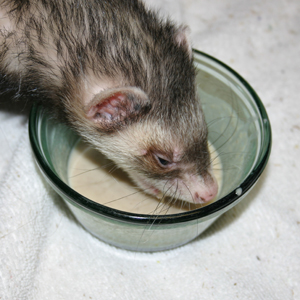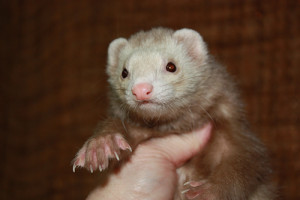Bob Church uses “ferret language” to stop his ferret Rummy from biting hard.
Rummy and I had an interesting start in our relationship. When I first met the little female ferret, I was warned she would nip on occasion. Ignoring this good advice, I decided to give her a bit of food. She dunked her head into the bag as I was pouring and when I moved her, she lived up to the warning and latched onto my thumb. It was a good latching as well; it took a few minutes to convince her the food was preferable to my flesh.
Despite my lacerated thumb, Rummy came home with me. For the first couple of weeks, she continued to nip, sometimes quite hard. It became quite apparent that I had to make a choice — either learn to live with the occasional nip, or figure out a way to convince her nipping was not an acceptable option without resorting to corporal punishment.
Reasons For Nipping
My first task was to attempt to understand the reason behind the behavior. Ferrets bite for a number of reasons. Some of the most common motivations include: just to get their way, out of instinct leftover from wild polecat behaviors (in hybrids), because of fear, while play fighting, when dominating another ferret, during territorial defense, from a reaction to pain, from poor human socialization, and as part of a mating ritual.
It wasn’t easy to discern Rummy’s rationale for nipping, but I finally decided Rummy bit for a couple of reasons. First, Rummy is a bit high-strung and excitable for a ferret, making her prone to sudden hard bites. Not just warning or defensive bites either; it didn’t take a lot for her to forget the rules of play and sink her teeth into tender skin a bit harder than she should. Second, Rummy spun around and gave a good nip when she was being picked up. I think she discovered that a good hard bite made people leave her alone, which was especially important when she wanted to get into mischief.
My strategy was not to stop Rummy from biting; play biting is an important aspect of ferret psychology, and I think the prevention of normal behavior borders on cruelty. Rather, I wanted to convince Rummy to stop biting people when being picked up and to teach her that soft bites were appropriate, but hard bites were not. Sounds easy, doesn’t it? Did I mention you should have adhesive bandages on hand?
Training To Allow Being Picked Up
My first task was to get Rummy strongly bonded to me — not as an owner, but as a companion. Several times a day, I picked up Rummy and did a light scruff. Then I carefully washed her face, eyes and ears with a damp washcloth, afterward using it to clean her bottom in a similar fashion. I used short, soft strokes to simulate a loving ferret mother’s tongue. I kept my fingers away from Rummy’s mouth while washing because the temptation to nip a finger was sometimes too difficult for her to ignore. It only took a week or so for Rummy to start looking forward to this grooming ritual, and her nips at being picked up all but stopped.
My next task was to figure out which treats were Rummy’s favorites. I experimented with a number of healthy treats for ferrets, and Rummy made it clear she would do just about anything for salmon jerky. So, now I picked her up, groomed her and then gave her a favored treat before setting her down so she could run off to a hidey-hole to consume her snack in private. The technique worked wonders. After just two weeks, Rummy stopped nipping! Well, not when playing, but I — or anyone — could pick her up without fear of the “spin-n-nip.”
After several weeks, I started to randomly not give a treat or groom her so she got used to being handled without being bribed. Over time, the treats became a once-a-day occurrence, but I continued to give her a fast, light grooming with my fingers each time I picked her up. Rummy became very bonded to me because of this — she followed me around, slept on my lap and became trustworthy enough for me to allow her to groom my eyebrows and ears.
Training To Bite Gently
Phase two was to teach her how to bite without hurting people: a sort of “play without pain” approach to ferret wrangling. Again, I resorted to copying normal ferret behaviors during this training, this time acting like a combination of mother and sibling.
My approach was to initiate play and wrestle Rummy with my hand as if I were any other ferret. As long as her play bites were soft, I continued to play. The moment her play bites became too hard, I made a loud squealing sound, said “No!” in a sharp voice, then scruffed her and held her to the floor for about five seconds. As you can see, I essentially followed the same “play fight” rules as any other ferret — squealing and scruffing come straight out of the “How To Be A Ferret” handbook. It took Rummy all of two days to understand what I wanted from her, and her hard play bites simply stopped. It was that simple.
In just a few weeks, I turned a nasty nipper into a well-bonded and sweet companion, one that could be trusted with other people, and one that considered me a trusted companion and friend. This was not accomplished by punishment, but by using the ferret’s inborn “behavioral rules” to adjust behavior. The advantage of this approach is that it is low-stress for the ferret and it is easy for the ferret to understand. The lack of corporal punishment is also good; if you try to stop a negative behavior using fear of pain, it is possible you will only make the situation worse.
Rummy and I are now great friends, and I can trust her without hesitation. I just needed to learn how to speak her language and communicate on her level.




